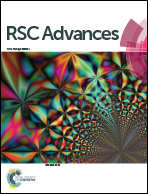Cadmium(ii) supramolecular complexes constructed from a phenylbenzoxazole-based ligand: self-assembly, structural features and nonlinear optical properties†
Abstract
A new phenylbenzoxazole-based ligand bearing a pyridyl group (abbreviated as L) was designed and applied for self-assembly with corresponding cadmium(II) salts to generate four coordination complexes, namely, C19H15CdCl2N3O (1), C19H15Cd2Br2N3O (2), C40H38Cd2I4N6O4 (3) and C21H15CdN5OS2 (4). All the complexes 1–4 were fully characterized by single crystal X-ray diffraction. In 1 and 4, new supramolecular architectures are built mainly through synergistic effects of coordination bonds, hydrogen bonding interactions based on the anions and the benzoxazolyl nitrogen (oxygen) atom. There are more C–H⋯π and π–π stacking interactions constructing the higher dimensional structure in 2 and 3, respectively. In addition, in complex 3, we observe that CH3OH molecules are dispersed in the supramolecular structure and play a vital role in building the supramolecular structure. The nonlinear optical (NLO) properties of the complexes were investigated using the Z-scan technique, which showed that complexes 1 and 3 have obvious nonlinear absorption compared to ligand L.


 Please wait while we load your content...
Please wait while we load your content...